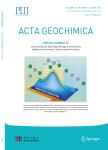Geochemistry of subsurface Late Quaternary ironstones in Rajshahi and Bogra Districts, Bangladesh: implications for genetic and depositional conditions
Geochemistry of subsurface Late Quaternary ironstones in Rajshahi and Bogra Districts, Bangladesh: implications for genetic and depositional conditions作者机构:Department of Geology and Mining University of Rajshahi Institutes of Mining Mineralogy and Metallurgy (IMMM)BCSIR Department of Disaster Resilience and EngineeringPatuakhali Science and Technology University
出 版 物:《Acta Geochimica》 (地球化学学报(英文))
年 卷 期:2019年第38卷第3期
页 面:404-413页
核心收录:
学科分类:0709[理学-地质学] 0819[工学-矿业工程] 07[理学] 0708[理学-地球物理学]
基 金:Australasian Institute of Mining and Metallurgy AusIMM
主 题:Ironstone Geochemistry Goethite Siderite Bangladesh
摘 要:The present study deals with the geochemistry of Late Quaternary ironstones in the subsurface in Rajshahi and Bogra districts, Bangladesh with the lithological study of the boreholes sediments. Major lithofacies of the studied boreholes are clay, silty clay, sandy clay, fine to coarse grained sand, gravels and sands with(fragmentary) ironstones. The ironstones contain major oxides, Fe_2 O_3*(*total Fe)(avg. 66.6 wt%), SiO_2(avg. 15.3 wt%), Al_2 O_3(avg. 4.0 wt%), MnO(avg. 7.7 wt%), and CaO(avg. 3.4 wt%). These geochemical data imply that the higher percentage of Fe_2 O_3* along with Al_2 O_3 and MnO indicate the ironstone as goethite and siderite, which is also validated by XRD data. A comparatively higher percentage of SiO_2 indicates the presence of relative amounts of clastic quartz and manganese-rich silicate or clay in these rocks. These ironstones also have significant amounts of MnO(avg. 7.7 wt%) suggesting their depositional environments under oxygenated condition. Chemical data of these ironstones suggest that the source rock suffered deep chemical weathering and iron was mostly carried in association with the clay fraction and organic matter. Iron concretion was mostly formed by bacterial build up in swamps and marshes, and was subsequently embedded in clayey mud.Within the coastal environments, the water table fluctuates and goethite and siderite with mud and quartz became dry and compacted to form ironstone.



